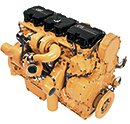"We have achieved efficient combustion, with low emissions and improved fuel economy," said John Campbell, director of on-highway engine products for Caterpillar Power Systems, located in Mossville, Ill. The calls the technology ACERT, or Advanced Combustion Emissions Reduction Technology., ACERT represents the largest and most expensive product development effort in the company's 75-year history, says James Parker, Caterpillar vice president in charge of power systems. Although he declined to say how much specifically the manufacturer has spent thus far on emissions R&D, he said it was "not more than $1 billion." The Peoria, Ill.-based Company reports investing $700 million on total R&D in 2001.
 |
| CAT claims to have extended the life of diesel technology with its new emission-complaint ACERT engines. (Photo courtesy of Caterpillar Inc.) |
These estimates are lower than previously believed industry rumors surfacing since CAT abandoned cooled exhaust-gas recirculationa more widely adopted technology for on-highway vehiclesin March 2001. With emission-reduction schedules tightening up today and in the years ahead, major engine manufacturers have been scrambling to meet compliance deadlines without losing forethought (ENR 3/17 p. 26). Nevertheless, a top official with the U.S. Environmental Protection Agency recently told ENR that engine manufacturers still have yet to prove long-term efficacy with their new designs, and "there is still a lot of work that needs to be done."
CAT engineers summarized how the new technology works by identifying four areas it targets on enginesintake air handling, combustion, electronics and exhaust aftertreament. Representatives pointed out key components, such as single and series turbocharging for cooling intake air; variable valve actuation for improving fuel burns; electronic multiplexing for integrating computer control; and catalytic conversion for reducing tailpipe particulate emissions. Working in concert, these subsystems allow the company to increase fuel savings by 8 to 10%, says Randy Blanton, director of Caterpillars advanced electric system division.
"ACERT didn't just happen," said Tana Utley, director of engineering for CAT's performance engines. "Although our main concern has been an October 2002 deadline, we knew we wanted to find a more long-term solution." Utley also argued that EGR, which the company had fully developed by March 2001, posed compromises for performance and fuel consumption. The company "couldn't find a win-win for our customers with cooled EGR it did not seem like the right solution for the future," she said. Parker added that meeting emission regulations without regard to customer value was not "an acceptable path" for the company.
The five new ACERT engines, slated for full production by October, will range between 190 to 550 hp, and will establish a base platform for future on-highway products. For the EPA's next off-highway market compliance deadline in 2005, Utley said the company plans to "tailor" existing on-highway ACERT engines, with few modifications, and brand them under the CAT and Perkins banners.
Although CAT engineers admitted that EGR works well for some applications, they expect ACERT will make a significant contribution to the equipment marketplace. Says Utley: "There are many challenges yet to come, but we believe ACERT will prolong the life of the diesel engines as a primary power source."
![]()
